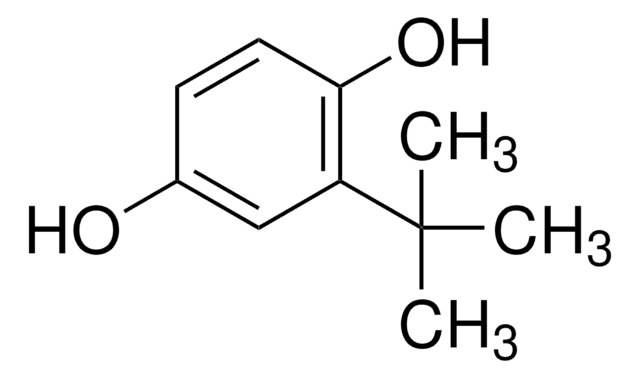B1253
Hydroxyanisole butylé
≥98.5%
Synonyme(s) :
2(3)-t-Butyl-4-hydroxyanisole, BHA, Éther monométhylique de la 2(3)-t-butylhydroquinone, 2(3)-t-Butylhydroquinone monométhyl éther
About This Item
Produits recommandés
Densité de vapeur
6.2 (vs air)
Niveau de qualité
Pureté
≥98.5%
Forme
powder
Température d'inflammation spontanée
599 °F
Pf
58-60 °C (lit.)
InChI
1S/C11H16O2/c1-11(2,3)9-7-8(13-4)5-6-10(9)12/h5-7,12H,1-4H3
Clé InChI
MRBKEAMVRSLQPH-UHFFFAOYSA-N
Vous recherchez des produits similaires ? Visite Guide de comparaison des produits
Description générale
Application
- Antioxidant peptides from silk protein: Research explores the purification of novel antioxidant peptides derived from Bombyx mori pupae, identifying potential antioxidant applications for butylated hydroxyanisole in the food and cosmetic industries (Chukiatsiri et al., 2024).
- Industrial lubricant additive: The performance of olive oil-based blended esters with butylated hydroxyanisole is evaluated, showcasing its efficacy as an industrial lubricant additive and its optimization using response surface methodology (Thangaraj et al., 2024).
- Environmental degradation studies: Investigates the degradation of butylated hydroxyanisole using advanced oxidation processes, providing insights into environmental safety and the compound′s stability in pharmaceutical and industrial applications (Shi et al., 2024).
Autres remarques
Mentions de danger
Conseils de prudence
Classification des risques
Aquatic Chronic 2
Code de la classe de stockage
11 - Combustible Solids
Classe de danger pour l'eau (WGK)
WGK 2
Point d'éclair (°F)
241.9 °F - Pensky-Martens closed cup
Point d'éclair (°C)
116.6 °C - Pensky-Martens closed cup
Équipement de protection individuelle
Eyeshields, Gloves, type P3 (EN 143) respirator cartridges
Faites votre choix parmi les versions les plus récentes :
Déjà en possession de ce produit ?
Retrouvez la documentation relative aux produits que vous avez récemment achetés dans la Bibliothèque de documents.
Les clients ont également consulté
Notre équipe de scientifiques dispose d'une expérience dans tous les secteurs de la recherche, notamment en sciences de la vie, science des matériaux, synthèse chimique, chromatographie, analyse et dans de nombreux autres domaines..
Contacter notre Service technique






